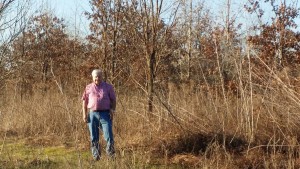
Mississippi landowner, Leo Pittman Edwards, has always made conserving and improving his land a priority. With 500 acres enrolled in the Conservation Reserve Program (CRP), he has seen an improvement in erosion control and wildlife habitat on his land in the Mississippi Delta.
Leo Pittman Edwards, a landowner near Cleveland in Bolivar County, Mississippi, has worked to improve the land on his farm for many years. Edwards’ land is located in the Mississippi Delta near a bogue, or a stream, making the land highly susceptible to erosion.
Edwards, a retired insurance agent, worked with the USDA Farm Service Agency (FSA) in the early 1990s to help preserve and restore wetland areas. In 1998, Edwards returned to the Bolivar County FSA office looking for a conservation program to help control erosion and prevent his land from washing away.
To continue his conservation endeavors, Edwards enrolled 36 acres in the Conservation Reserve Program (CRP) concentrating on creating vegetative cover and establishing new trees on the farm. Today, 17 years after the initial enrollment, Edwards has nearly 500 acres enrolled in CRP, which is celebrating its 30th anniversary this year.
CRP is a voluntary program that allows eligible landowners to receive annual rental payments and cost-share assistance to establish long-term, resource-conserving covers on eligible farmland throughout the duration of their 10-to-15-year contracts.
Under the program, farmers and ranchers plant grasses and trees in fields and along streams or rivers. The plantings prevent soil and nutrients from washing into waterways, reduce soil erosion that may otherwise contribute to poor air and water quality, and provide valuable habitat for wildlife.
Edwards currently has eight CRP contracts which include a variety of conservation practices including wildlife food plots, riparian forest buffers, wetland restoration and tree and shrub habitats for pollinators.
Edwards enjoys watching the vegetation and tress mature and believes that his conservation efforts are improving the land.
“I am very satisfied with the way CRP has helped improve my farm,” said Edwards. “Along with stopping the erosion I am also developing improved wildlife habitats. I’m seeing more deer, bobwhite quail, ducks and rabbits on the farm today than I have in a long time. Preserving the land and our natural resources are important to me.”
Edwards has a few CRP contracts that will expire soon, but he plans to reenroll the land to continue sound conservation practices.
Since being established on December 23, 1985, CRP has helped prevent more than 8 billion tons of soil from eroding and protected more than 170,000 stream miles with riparian and grass buffers, more than 100,000 acres of bottomland hardwood trees, nearly 300,000 acres of flood-plain wetlands, and 250,000 acres each for duck nesting habitat and upland bird habitat.
2015 marks the 30th Anniversary of CRP. For an interactive tour of CRP success stories from across the U.S., please visit the FSA CRP 30th Anniversary website at http://www.fsa.usda.gov/CRPis30.





